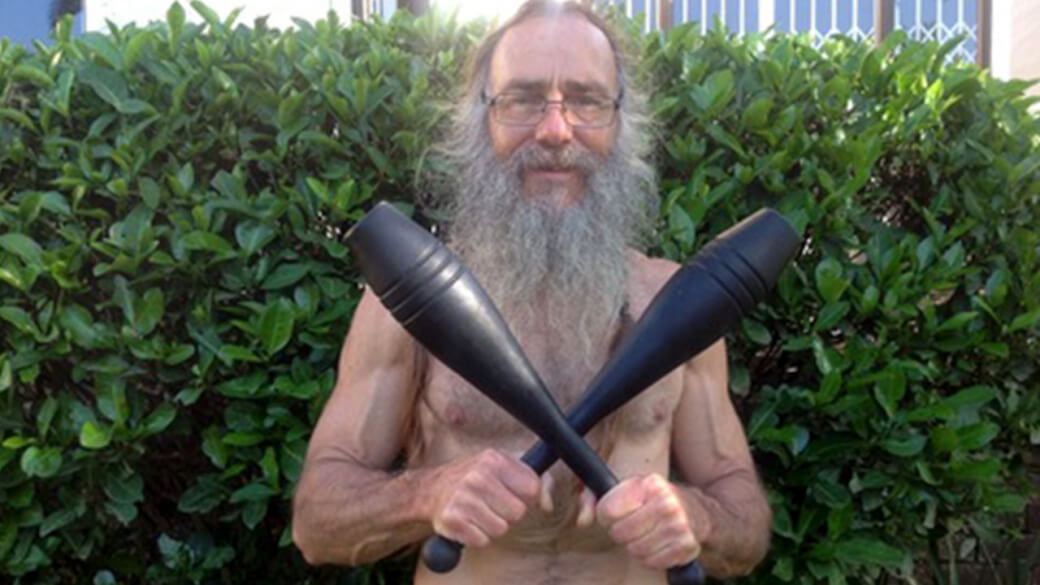Andreas Vogelsang
Andreas Vogelsang wrote to me in early 2014, about making and carving his own Indian Clubs. We have corresponded and discussed many aspects of swinging clubs since then, and I am sure we will continue to do so, well into the future. I think that you will find that Andreas Vogelsang has a genuinely fresh point of view about club swinging.
What is your sporting background?
Andreas Vogelsang:- I live close to the sea. I windsurfed for 10 years. In 2003, I bought two second-hand kites and began kiteboarding as well.
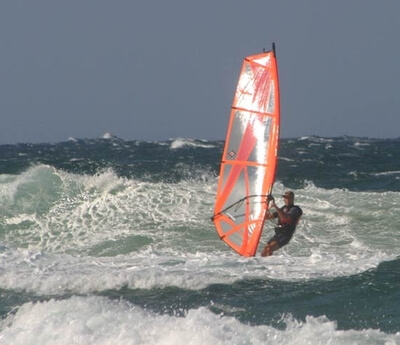 |
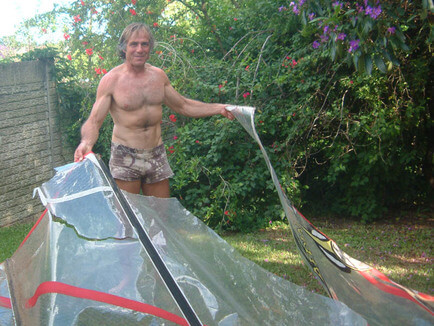 |
Windsurfing and kiteboarding are expensive sports because the equipment gets damaged by waves. With experience, you learn to keep the kite in the air when you get tumbled by a wave, and nowadays my kites last about 150 sessions (I keep records!)
 |
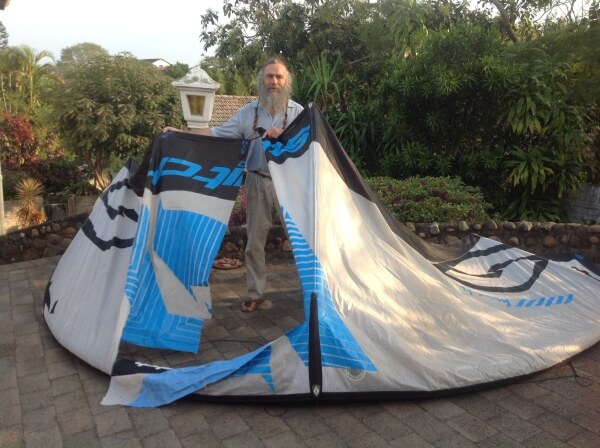 |
What is your professional background?
Andreas Vogelsang:- I have a degree in industrial chemistry. For most of my life, I worked for a company that makes wood adhesives. The company is located 5 minutes from the beach. I had a very understanding employer. He allowed me to store my kites and windsurfers in a laboratory storeroom. On windy days, I would load my gear into my car, and go to the beach for a few hours of surfing.
I had plenty of money, and perhaps not much time to spend it, so I took voluntary early retirement. My employer did not want to lose my services, so I continued to work part-time as a consultant.
I studied heart failure and came to an important conclusion Moderate Exercise Improves Survival Rates.
There is no cure for heart failure. The heart gets progressively weaker and weaker until you die. The big danger is not that the heart stops beating. The danger is organ failure. The liver, kidneys, lungs and brain all depend on a healthy flow of blood. If the flow gets reduced, then these organs get damaged.
Years ago, people with heart failure were advised to take things easy, to minimise stress to the heart. But recent studies have shown that the opposite is true.
Moderate exercise improves survival rates. The reason for this is the increased volume of blood circulating while exercising, bringing relief to the kidneys and liver. So I wondered what kind of exercise would be most beneficial.
The exercises had to be enjoyable. This would ensure that I would continue doing them (compliance).
The exercises had to have a cardiovascular component (to get the heart rate up).
The exercises had to have a skeletomuscular component, to produce human growth hormone.
Added bonus if the exercises challenged the mind as well as the body.
Added bonus if the exercises reinforced the body’s balance mechanism.
What is your reason for swinging Indian Clubs?
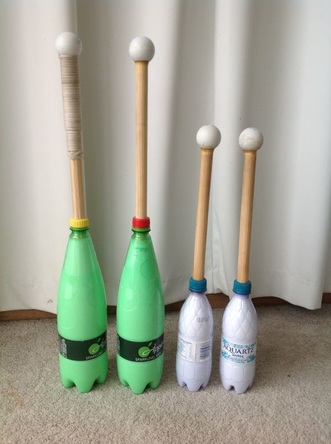 Andreas Vogelsang:- Quite by chance, I stumbled across a video of Thierry Sanchez swinging Indian clubs. I was so intrigued, that I made a pair of clubs out of plastic bottles, dowel rods and ping pong balls.
Andreas Vogelsang:- Quite by chance, I stumbled across a video of Thierry Sanchez swinging Indian clubs. I was so intrigued, that I made a pair of clubs out of plastic bottles, dowel rods and ping pong balls.
I watched Paul Taras Wolkowinski’s video tutorials and started to swing. I noticed that swinging Indian Clubs had something that differentiated it from other types of exercise I did in the past – the fun factor!
I read that repetitive rhythmic movement releases serotonin (which makes it enjoyable) and dopamine (which makes it addictive).
Chewing gum and pushing buttons on mobile phones has a similar effect, but swinging clubs is healthier! This is a very important consideration. It is easy to find something that is rhythmic and repetitive (and therefore enjoyable and addictive) like bouncing a ball or playing with a yoyo, but ineffective as exercise. It is also easy to devise effective exercise which is un-enjoyable unless you are a masochist. Swinging Indian clubs offers the best of both worlds.
What is the effect on heart rate?
Andreas Vogelsang:- I have a heart monitor and started measuring heart rate while doing different exercises with Indian clubs. As expected, the exercises that incorporated the larger muscles, like legs and back, had a bigger effect on heart rate.
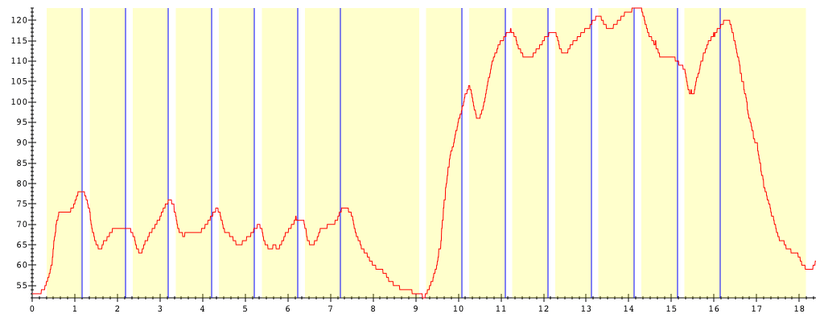
So I created a family of cross crawl exercises that were very cardiovascular, even when I used small Indian clubs to do them.
There is another reason for incorporating the larger muscles in an exercise routine. The legs and back are the growth hormone generators for the human body! The heart, being a muscle, can be re-modelled. (This is one reason for taking beta-blockers). I was hoping to achieve heart remodelling with specific exercises using Indian clubs.
One of the defining moments for me was watching Ron Jones do what he calls the Zenkahuna Pattern. I immediately recognized this as being a whole-body exercise done with Indian clubs. Legs, back, arms, shoulders and heart, all in one exercise! Another defining moment was when I saw Rik Brown do gravediggers. It is also an excellent whole-body exercise!
The video clips below show whole-body exercises done with one and two clubs.
These two exercises (the Zenkahuna Pattern and the Torso Twisters) are my staple bread and butter exercises. It is easy to get my heart rate up, and to maintain it for an extended period of time.
Can you talk about your homemade clubs?
Andreas Vogelsang:- I started making clubs out of discarded wood that I found in the neighbourhood. The wood invariably had some sort of natural defect, like borer tunnels, cracks, knots, and fungal discolourations. I find these defects attractive. If the defects don’t affect the functionality, I will try to incorporate them into the design of the club.
I made all the clubs entirely by hand, without any power tools. Being a good scientist, I kept notes and documented everything I did. I started a web page, initially to promote a certain type of exercise done with Indian clubs (cross crawl exercises). But it quickly became a journal of my club making activities.
The picture below is of the clubs I use most often. I have heavy meels, but I seldom use them. You can also see a shena, and an unfinished Tai Ji bang (the piece of wood that looks like an octagonal rolling pin.)
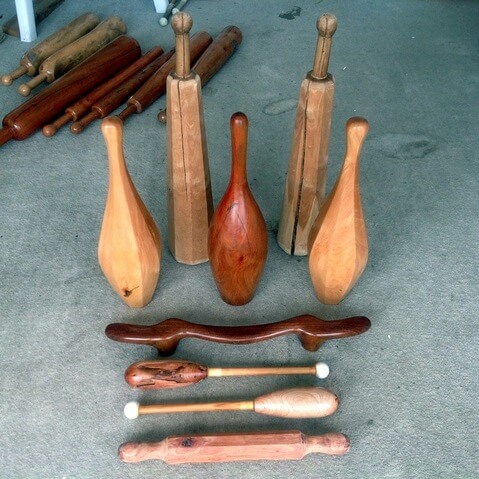
Which pair of clubs would I choose to have with me on a desert island?
Andreas Vogelsang:- Ideally I would like to have a pocket knife instead of clubs because then I can make any type of club I like! If I had to pick one pair, it would be my 2 lb plastic clubs. They are extremely durable, and can be used to crack open clams, coconuts and crayfish when not being used for exercise!
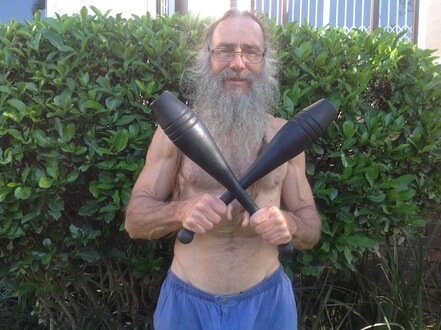
What are the benefits of club swinging for the average person?
Andreas Vogelsang:- I can’t speak for the average person. In my case, swinging Indian clubs has improved the quality of my life. The 5-year mortality rate for male congestive heart failure patients is 75% (women with CHF live longer).
I don’t know whether swinging clubs have had an effect or not. I might be one of the 25% who would have survived anyway. But one thing is for sure. I will keep swinging Indian clubs until I keel over!
What are your concluding remarks?
Andreas Vogelsang:- I hope to generate some healthy debate with this!
Andreas Vogelsang:- Over the years, I have come to the realization that there are 5 different categories of exercises that can be performed with Indian clubs. There is considerable overlap between these categories. But it is possible to steer or direct the exercises to obtain the desired effect.
The first two classes are neuromuscular exercises, the third is cardiovascular, the fourth is skeletomuscular, and the fifth is balance exercises.
The aimless swinging of a single Indian club. The mind doesn’t focus on anything specific. Most of us do this to warm up, and sometimes to relax. If you do this for about 5 minutes, the brain releases neurotransmitters like serotonin (which makes it feel good) and dopamine (which makes it addictive). I have found long and slender clubs (about 800g to 1.2kg, 66cm long) to be best for this because they have a lazy, laid-back swing. Ron Jones does this a lot, either with a sturdy stick or a light meel. And surprisingly, Harry Allick does this as well but using two light clubs.
Learning to swing two light to moderate Indian clubs in a defined pattern. This creates new synaptic junctions (in order to “hardwire” the moves). Paul Taras Wolkowinski does this a lot.
Cardiovascular. The arms and shoulders are small muscles compared to the legs. So the best way to engage the heart is to involve the legs! I do this a lot.
Skeletomuscular. Swinging heavy Indian clubs falls into Category 4 – load-bearing exercises. (This is the same category that I lump shena, gada and meel exercises). As we age, we lose muscle mass and bone density. Load bearing exercises stimulate the production of growth hormone, which helps counter this.
Another thing that happens as we age, is that we lose our sense of balance (due to deterioration of the vestibular system). You can do exercises where you shift your weight from one leg to the other. Close your eyes while you swing and shift your weight. You are now deprived of visual cues for balance and need to rely on the vestibular system to maintain balance.
Andreas Vogelsang lives in South Africa
Read more articles by Andreas Vogelsang
My sincere thanks to you Andreas Vogelsang, for sharing your journey into the world of club swinging.
